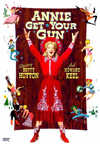Annie Get Your Gun
Warner Home Video
Cast: Betty Hutton, Howard Keel, Louis Calhern
Extras: Susan Lucci Introduction, Three completed numbers with Judy Garland, Deleted Number, Recording Sssion Takes, Trailer
Rating:
As famous as "Annie Get Your Gun" is, it had always been a lug-headed take on history. Rodgers and Hammerstein as producers had optioned the story for a musical. The team offered the property to Irving Berlin, who in 1946 delivered one of Broadway’s all-time greatest hits with Ethel Merman flamboyantly at its center.
Assigning Busby Berkeley can only have been a calculation on the studio’s part to counter Garland’s increasingly disruptive personal behavior with a disciplinarian certain to stand up to her. If so, it was a miscalculation. Though Berkeley’s talent as a dance director was undisputed, he’d produced no successes of note as a director.
It’s hard to think of anyone besides Betty Garrett from MGM’s own roster who’d be remotely suited as Annie. In the bold import of Betty Hutton from Paramount there was potential for danger since Hutton was thought to be insecure as a performer at the best of times. Never before or since was so much riding on her shoulders.
Replacement director George Sydney was known for eliciting high-octane performances (he certainly got the most out of Ann-Margret in ’Bye Bye Birdie’), and he proved right for Hutton. Her notorious hyper kinetic energy really pays off here!
Obviously, the show had the benefit of second thoughts. Once the production got its second wind, it clipped along at breakneck pace. The haste shows in mismatched shots here and there. For a movie honoured with an Oscar nomination for Art Direction, the show looked uncommonly artificial. After we detect that Buffalo Bill’s enormous Wild West show is meant to be all prop scenery, it is unnerving to find it sometimes hard to distinguish its fakery from that of the rest of the film. The set dressing is so perfunctory you can even see seams in the sod laid out in front of the Wilson House hotel!
Then it just up and disappeared. Rumours to account for "Annie Get You Gun"’s long unavailability tended to center on Irving Berlin. As the individual who’d almost single-handedly defined America in music, Berlin’s position in the pantheon of greats was assured. Although respect for his accomplishment never diminished, he could only witness demand for his unprepossessingly style recede from the public’s taste. Times had changed irrevocably as he struggled throughout the Sixties to produce one last opus, an original screen musical, "Say It With Music." His disappointment was bitter when Hollywood failed to deliver on the project.
Tantalizing glimpses of the film in MGM’s latter two "That’s Entertainment" anthologies held out no real hope that the public would see the whole film in the foreseeable future. Berlin’s iron will seemed to hold firm even from beyond the grave (he died in 1989 at the age of 101). Its triumphant struggle free of rights problems now bodes well for the two most highly anticipated video holdouts still remaining, "The High and the Mighty" (1954) and "Porgy and Bess" (1959).
The show’s rough charms ought to more than suffice. The digital transfer from "restored elements" is sharp and vivid. Latterly, some individual shots exhibit what appears to be grain from the original print. Otherwise, after minor artifacting and video noise during the opening titles, the picture settles in as one of the better of Warner’s consistently improving transfers. Color registration errors surface now and again, in single frames or fleeting frame sequences suggesting that effort has gone into sprucing the show up. The <$DD,Dolby Digital> 2-channel mono for the feature is undistinguished but serviceable. The French track is somewhat duller.
Garland’s ’I’m an Indian, Too’ was at long last released to the public in MGM’s fascinating compendium of rarities, "That’s Entertainment III." The expanded LaserDisc edition gave us Garland’s more laboured ’Doin’ What Comes Natur’lly.’ Here we’re treated to the complete version and we get to see it within the context of action before and after the song. This affords us a considerably more sympathetic regard for Garland’s performance.
In ’I’m an Indian, Too,’ we have a gem. It’s hard to imagine what could have made Garland a memorable Annie Oakley, but Robert Alton’s lustrous choreography reflects on her pleasingly. It easily bests Hutton’s version, which had been inexplicably restaged…badly. ’Colonel Buffalo Bill’ features Frank Morgan before his death and Geraldine Wall whose role was recast. What the public has never ever until now experienced is Betty Hutton’s ’Let’s Go West Again,’ written for the original show and filmed for the movie, but ultimately trimmed from both.
The original theatrical trailer rounds out the DVD’s offering. Production stills and dailies were amongst extras touted by Warner Home Video, and early word also had it that George Sidney had done a commentary. None of these items turn up on the disk, though bits can be glimpsed in the Lucci introduction. Anyway, we have ’the sun in the morning and the moon at night’ with the choice items we do get to experience for the first time even in so polished and complete a state as we do here.
"Annie Get Your Gun"…free at last!







